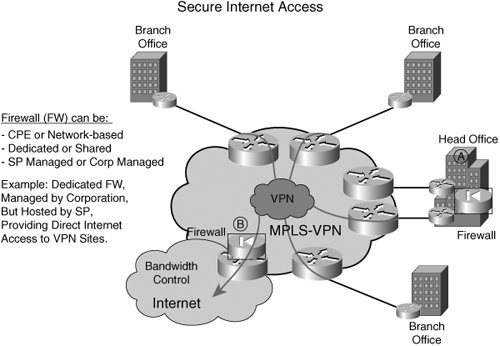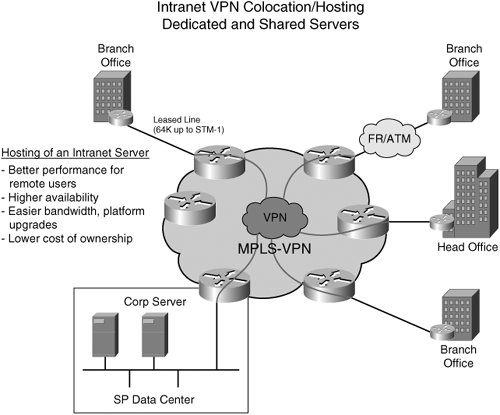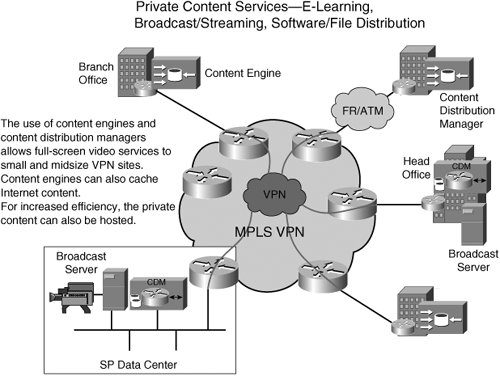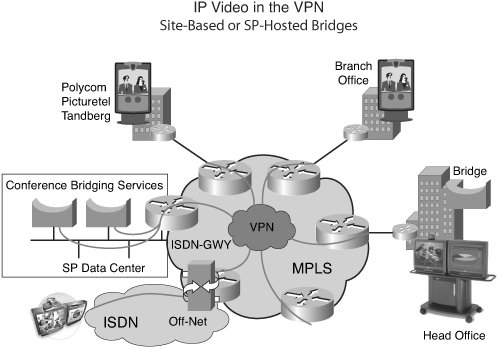Value-Added Services
| IP VPN, web, and content hosting are examples of services that service providers offer today and that can be offered via Layer 3 MPLS VPN technology. Additionally, managed security and firewall services, Internet access, VoIP with voice VPNs, and video services can be deployed using Layer 3 MPLS VPN technology. The opportunity to move up the value-added service chain via developing and deploying services based on Layer 3 MPLS VPN technology exists. A service provider can implement managed central services, such as VPN-aware HSRP/VRRP for server redundancy, VPN-aware NAT, and multicast VPNs. For secure Internet access, a firewall can be CPE or network-based, dedicated or shared, and managed by the service provider or by the enterprise itself. Figure 2-9 shows an example of a secure Internet access service. Figure 2-9. Secure Internet Access Building on these service blocks, the service provider can also develop a managed intrusion detection service (IDS) with antivirus scanning, URL filtering, and denial-of-service (DoS) protection services for the enterprise customer. An example of dedicated and shared server hosting for an intranet VPN using Layer 3 MPLS VPN technology is shown in Figure 2-10. Figure 2-10. Intranet VPN Colocation/Hosting: Dedicated and Shared Servers IP videoconferencing in the VPN can be implemented by the service provider via either a site-based or service providerhosted model, which is depicted in Figure 2-11. Figure 2-11. IP Video in the VPN: Site-Based or SP-Hosted Bridges The use of content engines and content distribution managers permits full-screen video services to small and mid-size VPN sites. Content engines can also cache Internet content, and for further efficiency, private content can be hosted. Applications, such as e-learning, broadcast streaming, and file/software distribution, are supported by such a capability. An example is show in Figure 2-12. Figure 2-12. Private Content Services: E-learning, Broadcast/Streaming, Software/File Distribution Multicast supports company video broadcasts, software distribution, music on hold for IP telephony, and e-learning applications (just to name a few). Via Layer 3 MPLS VPN technology, a service provider can develop and deploy a multicast VPN for enterprise customers. Figure 2-13 depicts a multicast VPN implementation. Figure 2-13. Multicast-Enabled VPN Services: Efficient Use of Access and Core Bandwidth Both service providers and enterprise customers can use Layer 3 MPLS VPN technology to develop, deploy, and subscribe to a range of value-added services. As IP VPNs become commoditized, the opportunity to provide differentiated services is excellent for both the service provider and enterprise customer. Finally, the service provider can provide end-to-end SLAs via the use of differentiated services to define service classes for various services such as voice, video, and data. Differentiated service (class of service) is discussed in Chapter 9, "Quality of Service." Figure 2-14 summarizes these value-added services. Figure 2-15 depicts the service expansion evolution for the service provider. Figure 2-14. Summary of Value-Added Services for IP VPNs Figure 2-15. Extend the Scope of SP Services: Complementing Connectivity with Value-Added Services |
EAN: 2147483647
Pages: 162

